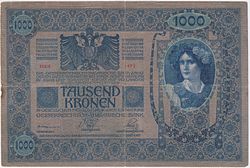Paper money of the Austro-Hungarian krone appeared in the beginning of the 20th century - almost ten years after the coins were introduced. All banknotes were bilingual (German and Hungarian), and the value was indicated in eight other languages (Czech, Polish, Croatian, Slovene, Serbian, Italian, Ruthenian (Ukrainian) [Notes 1] and Romanian). After the dissolution of the empire banknotes were overstamped to limit their circulation according to the new borders. [1]
Contents
| 1900-1902 Series | ||||||||
|---|---|---|---|---|---|---|---|---|
| Image | Value | Dimensions | Description | Date of | ||||
| Obverse | Reverse | Obverse | Reverse | printing | issue | withdrawal | ||
 |  | K 10 | 121 × 80 mm | Puttos | Puttos | 31 March 1900 | 2 September 1901 | 28 February 1907 |
 |  | K 20 | 131 × 87 mm | female model symbolizing Austria | female model symbolizing Hungary | 20 September 1900 | 30 June 1910 | |
 |  | K 50 | 150 × 100 mm | female models | female models | 2 January 1902 | 26 May 1902 | 31 December 1916 |
 |  | K 100 | 160 × 106 mm | Allegories of sciences and industry | Allegories of arts and agriculture | 20 October 1902 | 31 August 1912 | |
 |  | K 1,000 | 191 × 127 mm | female model | female model | 2 January 1903 | 31 December 1918 | |
| 1904-1910 Series | ||||||||
 |  | K 10 | 140 × 80 mm | Princess Rohan | Princess Rohan | 2 January 1904 | 25 February 1905 | 31 December 1918 |
 |  | K 20 | 150 × 89 mm | female model | female model | 2 January 1907 | 22 June 1908 | 31 December 1915 |
 |  | K 100 | 163 × 107 mm | 2 January 1910 | 22 August 1910 | 31 May 1915 | ||
| 1912-1915 Series | ||||||||
 |  | K 10 | 150 × 80 mm | boy model | boy model | 2 January 1915 | 24 July 1916 | 31 December 1918 |
 |  | K 20 | 150 × 89 mm | female model | female model | 2 January 1913 | 29 September 1913 | |
 |  | K 50 | 162 × 100 mm | 2 January 1914 | 18 December 1916 | |||
 |  | K 100 | 163 × 107 mm | 2 January 1912 | 13 December 1912 | |||
| War Series | ||||||||
| K 1 | female model | denomination | 5 August 1914 | |||||
| | | K 1 | 112 × 67 mm | classic architecture pattern | Phrygian head | 1 December 1916 | 21 December 1916 | 31 December 1918 |
| | | K 2 | 112 × 67 mm | female model | denomination | 5 August 1914 | 16 August 1914 | 31 July 1917 |
 |  | K 2 | 125 × 85 mm | female models | female models | 1 March 1917 | 9 July 1917 | 31 December 1918 |
| K 5 | female model | female model | 5 August 1914 | |||||
| Postwar issues (limited validity) | ||||||||
| K 5 | female model | female model | 1 October 1918 | 31 December 1918 | ||||
 |  | K 25 | 135 × 80 mm | plain or wavy pattern | 27 October 1918 | 30 October 1918 | ||
 |  | K 200 | 168 × 100 mm | |||||
 |  | K 10,000 | 191 × 127 mm | female model | 2 November 1918 | 19 December 1918 | ||
| These images are to scale at 0.7 pixel per millimetre. For table standards, see the banknote specification table. | ||||||||